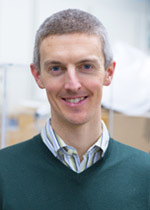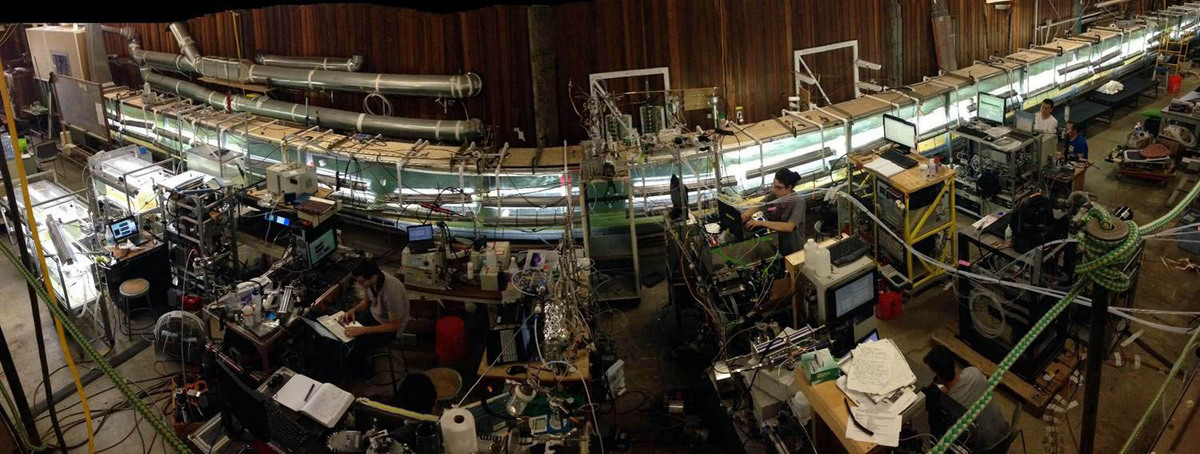Researchers turn to the ocean to help unravel the mysteries of cloud formation
Sea spray aerosol particles occur naturally at the ocean-air boundary and can help to seed new clouds. Along with collaborators, the Bertram group studies sea spray aerosol on research cruises and also in controlled laboratory environments.
Photo: Michelle Kim
In a study published today in ACS Central Science, a research team led by University of Wisconsin–Madison Chemistry Professor Timothy Bertram peels back the mysteries of the structures of tiny aerosol particles at the surface of the ocean.
The work shows how the particles’ chemical composition influences their abilities to take in moisture from the air, which indicates whether the particle will help to form a cloud — a key to many basic problems in climate prediction.
To understand the Earth’s climate, scientists must consider and measure both human-made environmental pollutants and naturally occurring processes that influence how much energy the planet absorbs from the sun or radiates back into space. One naturally occurring process that plays a big role in this delicate balance is the formation of clouds.

Timothy Bertram
Clouds are made of tiny droplets of water. It has long been known that the droplets that make up clouds form around tiny nuclei — grains of dust, salt or even microbial life.
Clouds help reflect solar energy back to space, but the process for a particle to seed a cloud can change depending on the natural setting. A particle must take up water from its surrounding environment in order to seed a cloud, but the particle’s chemical composition may be very uniform or very diverse, affecting its ability to do so.
Bertram’s group focuses on areas where chemistry significantly affects climate or the environment. And because oceans cover more than 70 percent of the Earth’s surface, the UW–Madison researcher has focused on the ocean surface in order to better understand an important piece of the larger climate picture.
“While the emission of particulates from the ocean isn’t nearly as strong as that from trucks, the majority of the Earth’s surface is not covered by trucks,” Bertram says. “The ocean may be a diffuse source (of these particles), but it’s a very important source.”
In their new work, Bertram and colleagues’ investigation began in a laboratory-based wave channel, which allowed them to replicate the types of sea spray aerosol particles found near ocean waves. They also studied particles from the actual ocean-air boundary. By mimicking ocean waves and sea spray in the wave channel, the researchers could gain insight into the structures and cloud-formation potential of particles in the open ocean.

The researchers used a 33-meter-long wave channel to replicate waves found in nature. They filled the wave channel, which is located at the Scripps Institution of Oceanography, with seawater from the ocean.
Photo: Christina McCluskey
The team then developed a new method that categorizes a diverse population of aerosol particles based on their likelihood of taking up water from the surrounding environment and forming a cloud. Previous approaches yielded one number to assess sea spray aerosol particles’ ability to form clouds. The new method, however, provides a more precise measure by indicating the percentages of particles in each category, thus more properly accounting for particle-to-particle variability in cloud formation.
“The advancement is that this is general,” Bertram says. “It’s a framework people can use broadly to look at this question of the diversity of particulates and how they impact cloud formation.”
Collaborators include other researchers affiliated with the Center for Aerosol Impacts on Climate and the Environment at the University of California, San Diego; the University of Iowa; the Scripps Institution of Oceanography; and the University of California, Davis, as well as a researcher from NOAA’s Pacific Marine Environmental Laboratory. Steven Schill, a graduate student in the Bertram group, is first author on the new study.
The National Science Foundation supported the work through the Center for Aerosol Impacts on Climate and the Environment.




